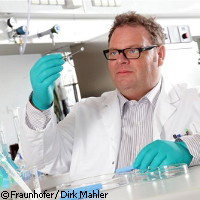Building the perfect cornea from scratch, the EU way
A team of European small and medium-sized enterprises (SMEs) together with scientists have developed an artificial cornea that could allow blind people to see, and save patients from the serious drawbacks of the conventional transplant method currently in use. So far, surgeons have been transplanting corneas from human donors. These companies have teamed up with public research institutes to build the perfect, high-tech prosthetic cornea. The CORNEA ('Development of an artificial cornea for the human eye') project was funded to the tune of EUR 1.78 million under the EU's Sixth Framework Programme's (FP6) Action Line for SMEs. Every year in Europe, 40,000 blind patients are put on a corneal transplant waiting list, whether they suffer from a hereditary condition or have lost their eyesight after an accident or illness. Unfortunately, this traditional approach is far from perfect; its success rate can top the 90% mark, or fall below 50%. Out of those patients who are lucky enough to find a compatible donor, many do not tolerate their new cornea well. Common side effects are dry eyes, acid burns or other serious eye problems. Adding further to this headache is that donated corneas are often simply not available in developing countries. A cornea implant is the perfect alternative. Designing and producing a good artificial cornea is no easy task, however. While other teams had tried it before, they failed to meet the complex requirements of the human eye. It took 3 years of development, plus the combined expertise of 12 European research teams, to get the right physical, chemical and biological properties. Firstly, the material must graft itself firmly onto the patient's eye; it has to be a good basis for the surrounding eye tissue to grow onto. Yet, no tissue should grow in the middle of the implant, otherwise the patient will not see. Secondly, the inner side of the cornea should stay perfectly clear, while the outer side of the transplant must be smooth and able to moisten with tears, so that the eyelid can slide across it seamlessly. To achieve all these characteristics, the CORNEA consortium used a polymer material and tested different types of coating. In particular, they picked a special protein - a growth factor that the natural eye tissue cells can detect and recognise. Triggered by this growth factor, the cells start growing on the surface of the implant's edge, exactly as needed. The teams also developed specific methods for sterilisation and tested the graft, both in vitro (on dissected pig tissues and cell cultures) and on live laboratory rabbits. Coordinated by the Fraunhofer Institute for Applied Polymer Research, Potsdam, Germany, and bringing together experts from Germany, France, the Netherlands and Poland, CORNEA succeeded thanks to the know-how involved. SME partners brought in the technical and development resources, together with the manufacturing capacity and more importantly market access. The UK-based SME IOI introduced its innovative patented keratoprosthesis design 'flexicornea' to the project. The artificial cornea is based on this design. German group CORONIS, along with the Fraunhofer Institute, developed and tested a flexible, hydrophobic, optical polymer that mimics the human cornea. In addition, two German SMEs have developed the mechanical manufacturing technology (Schmidt), and Rhine Tec has adapted its cell analyser and will commercialise this instrument. The corneal implant is now approved as a safe, custom-made medical device. It can be used on blind patients if other therapies fail, giving many patients the freedom to enjoy the world around them more fully.
Countries
Germany, France, Netherlands, Poland



